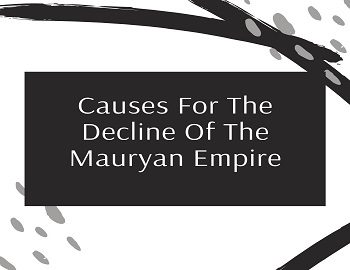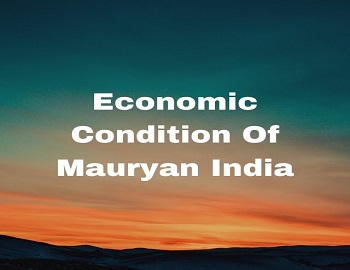Table of Contents
Following were the causes for the decline of the Mauryan Empire:
The dramatic suddenness with which the Maurya dynasty petered out within half-century of the death of Asoka is a strange phenomenon in Indian history. In most cases, the decline was a gradual process culminating in the extinction of the dynasty. The reasons given by historians for such a rapid decline are as conflicting as they are confusing. Some of the very obvious and other controversial causes for the decline of the Mauryan empire are discussed as follows-
The Partition of the Mauryan Empire & Weak later-Mauryan Rulers:
The Mauryan Empire began to decline with the death of Asoka in 232 B.C. Asoka seems to have been succeeded directly by two grandsons who divided his kingdom between them. The eastern half was ruled by Dasaratha and the western part by Samprati, son of Kunal.
Dasaratha’s existence is vouched for by brief dedicatory inscriptions in caves granted to the Ajivika ascetics. Samprati’s name though not mentioned in any inscription has been handed down by numerous local and few Jain traditions that place his capital at Ujjain. It thus seems reasonable to assume that Asoka empire was divided in the first instance between two grandsons and not much is known about these two persons.
The Western province was threatened from the north-west by the Bactrian Greeks, to whom it was practically lost by 180 B.C. From the South, the threat was posed by Andhra dynasty. Had the partition not taken place, the Greek invasions of the north-west could have been held back for a while. The partition of the empire disrupted the various services as well.
The eastern half, with its capital still a Patliputra, continued to be governed for nearly half a century by other successor listed in the Puranas. The weakness of these rulers can be imagined from the fact that as many as six rulers could rule only 52 years over the eastern part of the empire and finally, Brihadratha was the last ruler in the mainline of the Maurya and was assassinated by Pusyamitra Sunga, his commander-in-chief, in about 185 B.C. Thus within half a century after Asoka’s death, the Mauryan rule ended in India. These weak later-Mauryan rulers could also not continue the traditional policies of the Mauryas.
Brahmanical Revolt Against The pro-Buddhist Policies Of Asoka:
Harprasad Sastri holds the view that the fall of the Mauryan Empire was largely the result of a Brahmanical reaction against the pro-Buddhist zeal of Asoka. The ban on animal sacrifice was a direct attack on the Brahmanas and the employment of the Dhamma-mahamatras destroyed the prestige of the Brahmanas. He argued that the propagation of Buddhism disturbed the social and religious equipoise of the Brahmanas. The revolt of Pushyamitra was a manifestation of Brahmanical reaction against the religious policy of Asoka and his successors. But Sastri’s views are merely hypothetical because Asoka’s religious policy, based on humanism, aimed at universal tolerance and amity among all religious sects. The ban on animal sacrifices, sanctioned even in the Puranic literature, did not necessarily imply hostility towards the Brahmanas. The nature of the work of Dhamma-mahamatras was all-pervasive and they were also enjoined to look after the rights and welfare of the Brahmanas. Asoka’s solicitude for Brahmanas and sramanas is well attested when he inculcates the spirit of reverence to be shown towards them in his edicts. The propagation of Buddhism might have caused a ripple in the Brahmanical social and religious orders, but this was not of such a dimension as to enfeeble the Mauryan state. The theory that the Pushyamitra was leading a Brahmanical revolt when he killed Brihadratha is misleading because it was more of a coup and intrigue rather than conspicuous pro-Brahmin revenge. The very fact that Pusyamitra could become the commander-in-Chief is ample evidence of the fact that there was no discrimination against the Brahmins.
Asoka’s Pacifist Policy:
H.C. Raychaudhuri maintains that Asoka’s pacifist policies were responsible for undermining the strength of the empire. He says: “From the time of Bimbisara to Kalinga war, the history of India was the story of the expansion of Magadha from a tiny state in South Bihar to a gigantic empire extending from the foot of the Hindukush to the borders of the Tamil country. After the Kalinga war ensued a period of stagnation at the end of which the process is reversed. The empire gradually dwindled down in extent till it sank to the position from which Bimbisara and his successors had raised it.” However, Raychaudhuri’s view does not seem to be tenable, because Asoka did not turn complete pacifist after the Kalinga war in view of the fact that he neither demobilize the Mauryan army nor abolished capital punishment. Asoka only gave up the imperialist policy and preached non-violence after the Kalinga war. Such practical pacifism could not have been responsible for the decline of the Mauryan Empire.
Economic Decline:
DD Kosambi argues that during the reign of later Mauryans, the empire was grappling with a serious economic crisis. He talks about the almost desperate attempts made by the rulers to increase tax revenues, the
increased debasement of coins etc. He talks about Kautilya’s advice that virtually every human being should be taxed.
But Romilla Thapar counters him by saying that the Mauryan period was the first time when the role of taxes in augmenting the power of the empire was properly understood for the first time. So it was but natural for the
rulers to try and increase revenues. Moreover, the chronology of the debased coins is uncertain and it can’t be taken as conclusive evidence. It could be due to higher silver demand as well as due to weak control of the
later Mauryan rulers that their control over the periphery decreased and coins became debased. Moreover, some excavations in Sisupalgarh and Hastinapur reveal a prosperous economic state during the Mauryan
period.
The decline followed an interesting pattern. While the peripheries emerged into separate states, the metropolitan area also continued instead of declining. The disintegration of the empire was thus accompanied with economic development in the core and the peripheries and was not a period of economic decline.
Highly Centralized Administration:
Prof. Romila Thapar is of the view: “The machinery of the Mauryan administrative system was so centralized that an able ruler could use it both to his own advantage and that of his people, to the same degree it could become harmful to both under a weak ruler who would lose its central control and allow forces of decay to disintegrate and wreck it.” The weakening of the central control under the later Mauryas led automatically to a weakening of the administration. The division of the Mauryan Empire after the death of Asoka must have given a further blow to the centralized Mauryan administration under the weak later-Mauryan rulers, leading to the decline and disintegration of the Mauryan Empire.
- The Home Rule League, 1916
- Montagu Declaration or August Declaration [1917]
- Montagu-Chelmsford Reforms or the Government of India Act 1919
- Rowlatt Act, 1919
- Jallianwala Bagh Massacre [April 13, 1919]
- The Khilafat Movement, 1919-1920
- The Non-Cooperation Movement (1920-22)
- Simon Commission, 1927
- Gandhi-Irwin Pact: March 5, 1931
- The Government of India Act 1935
- Wardha Scheme of Basic Education, 1937
- Legacy of 19th Century– NIOS


![Montagu Declaration or August Declaration [1917] 3 August Declaration-1917](https://gkscientist.com/wp-content/uploads/2020/10/August-Declaration-1917-350x200.jpg)






Comments (No)